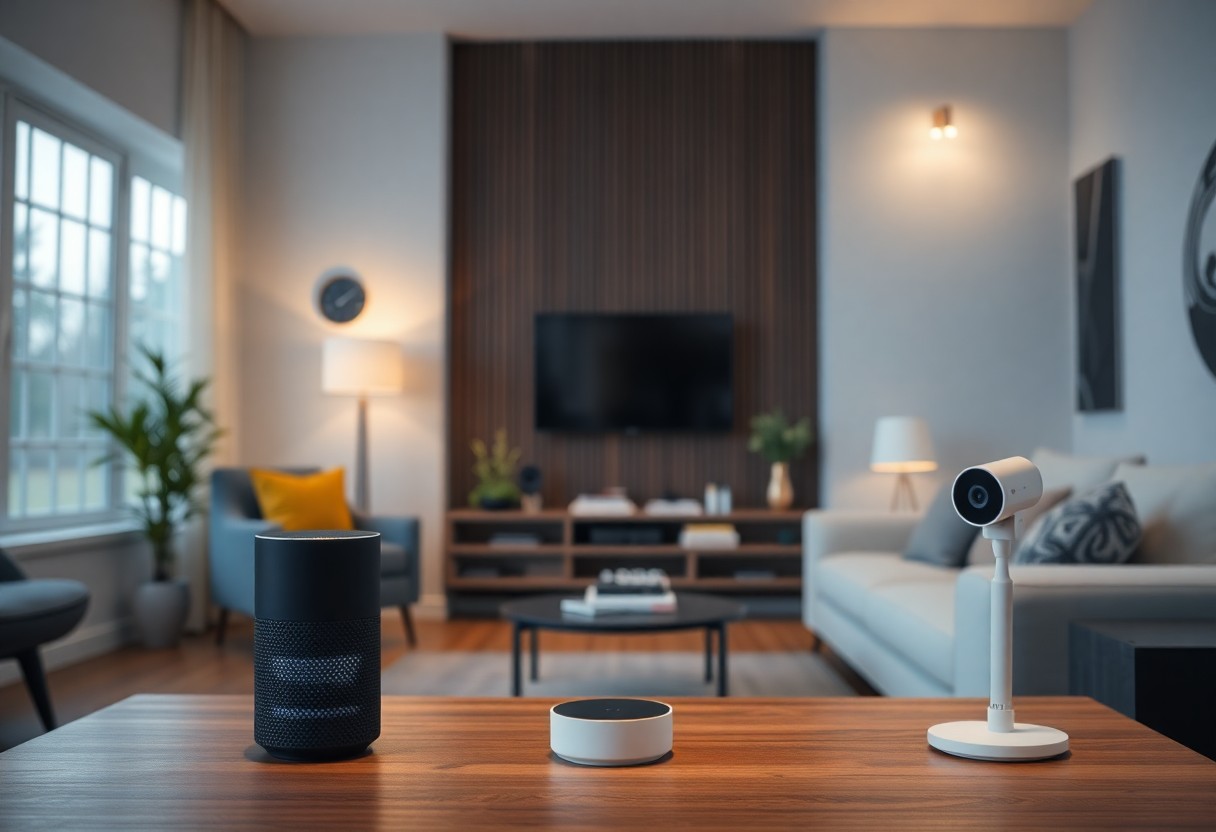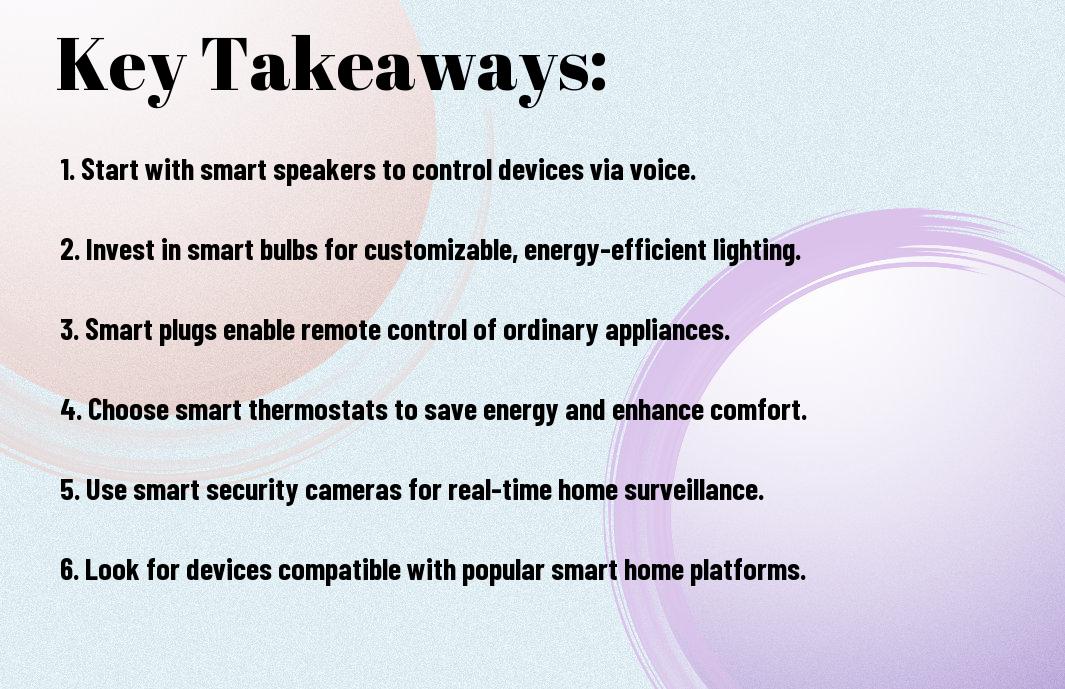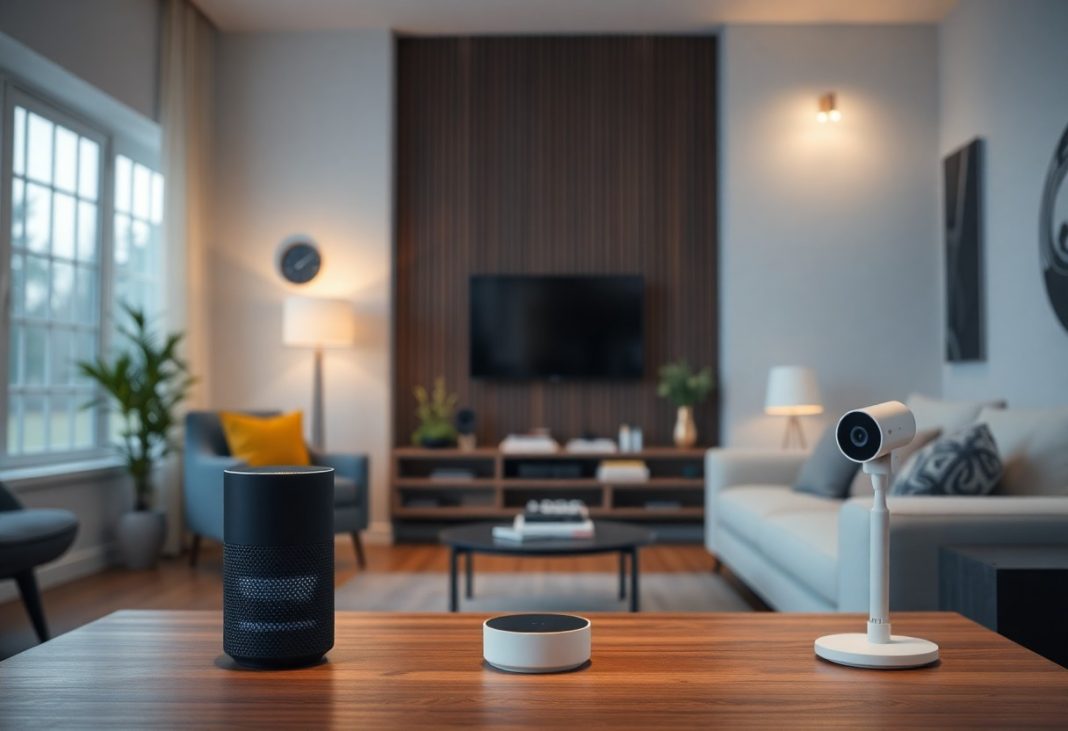Smart home technology offers you the convenience and efficiency to transform your living space with ease. Whether you’re just starting or looking to expand your system, there are numerous beginner-friendly devices designed to simplify daily tasks. This guide introduces you to imperative smart gadgets that fit seamlessly into your lifestyle, helping you control lighting, security, and climate directly from your smartphone. By leveraging these accessible tools, you can create a more comfortable, secure, and energy-efficient home environment tailored to your needs.
Key Takeaways:
- Home automation can be easily initiated with simple smart devices like smart plugs, bulbs, and assistants to control lighting and appliances remotely.
- Choosing compatible devices that work together within a single ecosystem (e.g., Alexa, Google Assistant, or Apple HomeKit) ensures smoother integration and control.
- Beginner-friendly smart products offer affordable options and straightforward installation, making it accessible for those new to home automation technology.
Overview of Home Automation
The concept of home automation allows you to control and monitor various household systems and devices automatically or remotely. By integrating technology such as smart devices and sensors, you can enhance the comfort, convenience, and security of your living space. Whether you want to adjust lighting, manage security cameras, or regulate temperature, home automation makes managing your home more efficient and tailored to your lifestyle.
What is Home Automation?
Beside simplifying daily tasks, home automation connects your devices and systems to a centralized platform, often accessible via smartphone or voice commands. This network of smart gadgets can include lighting, thermostats, security systems, and more, working seamlessly to respond to your preferences and routines and providing you control from anywhere.
Benefits of Home Automation
Any investment in home automation brings you increased convenience as you control multiple devices from one interface. It also offers enhanced security through automated locks and surveillance, energy savings by optimizing usage, and a more comfortable living environment that adjusts automatically to your needs, ultimately making your life easier and more enjoyable.
Apart from convenience and security, home automation can improve your home’s energy efficiency significantly. Automated systems can learn your schedule to reduce unnecessary power consumption, lower utility bills, and reduce your carbon footprint. Additionally, tailored automation can assist with accessibility, making your home more user-friendly for all members of your household.
Essential Smart Devices
Even if you’re new to home automation, integrating necessary smart devices can quickly transform your living space into a connected and efficient environment. These devices offer you convenience, security, and energy savings by interacting seamlessly with your daily routines. Starting with a few smart products lays the foundation for a smarter home that grows with your needs.
Smart Speakers
Along with voice control capabilities, smart speakers serve as the central hub for your home automation system. They allow you to manage various smart devices hands-free, stream music, set reminders, and access information instantly. By investing in a smart speaker, you make it easier to control your smart home using simple voice commands.
Smart Lights
To enhance your home’s ambiance and energy efficiency, smart lights offer customizable brightness and color settings controlled remotely or via schedules. You can adjust lighting to match your mood, save energy by automating on/off times, and increase security by simulating occupancy when you’re away. These lights provide a practical yet stylish upgrade to your home environment.
Further, many smart lighting options integrate with other automation devices and platforms, letting you create personalized scenes that trigger multiple actions simultaneously. For example, a “Good Night” scene could dim your lights, lock doors, and lower the thermostat, all activated by a single command, helping you streamline your daily routine effortlessly.

Smart Security Solutions
Keep your home safe and monitored with smart security solutions that you can easily control from your phone. These devices offer real-time alerts, remote access, and integration with other smart home systems, giving you peace of mind whether you’re home or away. From cameras to door locks, you can enhance the security of your property without complicated setups.
Smart Cameras
Smart cameras offer you live video feeds and motion detection alerts directly to your smartphone. You can set up zones to monitor specific areas, receive notifications of unexpected activity, and even communicate through two-way audio. These cameras provide a convenient way to keep an eye on your home anytime, improving your overall security.
Smart Door Locks
Beside enhancing security, smart door locks give you the convenience of keyless entry and remote locking or unlocking. You can grant temporary access to guests or service providers without needing to be onsite, and track who enters and exits your home through your phone.
At the heart of smart door locks is their ability to integrate with your home automation system, enabling voice control and automating access schedules. This flexibility not only secures your entry points but also simplifies your daily routine, making it easy to manage access permissions and ensure your home is protected.
Smart Thermostats
Your smart thermostat is an necessary device that intelligently manages your home’s temperature to create a comfortable environment while optimizing energy consumption. By learning your schedule and preferences, it adjusts heating and cooling automatically, helping you save on utility bills and reduce environmental impact. These devices can be controlled remotely via smartphone apps, giving you convenience and control no matter where you are. Investing in a smart thermostat is a practical way to enhance your home’s efficiency and comfort without complicated installation or maintenance.
How They Work
Before you set up a smart thermostat, it’s important to understand that it connects to your HVAC system and uses sensors and algorithms to monitor and adjust temperature based on your habits and preferences. Many models also incorporate weather forecasts and occupancy detection to optimize performance. By analyzing this data, the thermostat makes real-time adjustments to maintain your desired comfort levels while minimizing energy use, ensuring your home is warm or cool when needed but not wasting power when it’s unoccupied.
Benefits of Smart Thermostats
Behind the convenience of remote control and automated scheduling lies significant energy savings and enhanced comfort. A smart thermostat adapts to your lifestyle, preventing unnecessary heating or cooling and lowering your energy bills. Additionally, it contributes to a greener environment by reducing your carbon footprint, all while providing detailed energy usage reports that empower you to make informed decisions about your consumption.
In addition to saving money and energy, smart thermostats offer personalized comfort by learning your preferences over time and adjusting settings accordingly. Some models integrate with other smart home devices, allowing you to create comprehensive automation scenarios—for example, lowering the temperature when you leave home or syncing with smart blinds for optimal climate control. These features make your living space both smarter and more responsive to your lifestyle needs.
Home Automation Hubs
All smart home devices rely on a central system to communicate smoothly, and that’s where home automation hubs come in. These hubs serve as the brain of your connected home, allowing you to control various devices from one place. Whether you want to automate lights, thermostats, or security systems, a hub simplifies the process by integrating different brands and protocols under a single platform, making your home smarter and your daily routine easier.
What is a Home Automation Hub?
To understand a home automation hub, think of it as the central controller that links your smart devices together. It manages communication between your devices and your smartphone or voice assistant, enabling you to control everything remotely or through automated routines. Without a hub, your devices might operate independently, but with one, you gain seamless integration and consolidated control over your smart home system.
Popular Hub Options
By exploring popular hub options, you can find the right setup that fits your needs and existing devices. Some well-known choices include Amazon Echo with Alexa, Samsung SmartThings Hub, and Google Nest Hub. Each offers unique features, compatibility ranges, and user interfaces. Selecting the best hub ensures you maximize your system’s capabilities while keeping control simple and centralized.
With Amazon Echo, you get robust voice control and wide device compatibility, while Samsung SmartThings caters to more advanced setups with support for numerous protocols like Zigbee and Z-Wave. Google Nest Hub offers excellent integration with Google services and a user-friendly touchscreen display. Evaluating these hubs based on your current smart devices and future plans helps you build a cohesive and efficient home automation network.
Setting Up Your Smart Home System
Unlike complex tech projects, setting up your smart home system can be straightforward and enjoyable with the right approach. Start by selecting compatible devices that work well together, such as smart hubs, lights, and security cameras. Ensure you have a stable Wi-Fi network to support all gadgets seamlessly. By taking it step-by-step, you can customize your smart home to fit your lifestyle, enhancing convenience, security, and energy efficiency right from the start.
Planning Your Layout
Against the urge to rush into purchasing devices, you should first plan your smart home layout carefully. Consider the rooms you use most and the tasks you want to automate, like lighting, climate control, or security. Mapping out device placement ahead of time helps avoid overcrowding and ensures each component functions optimally within your home’s wireless network. A thoughtful layout will save you time and frustration as you expand your system.
Common Installation Tips
Home installations often go smoother when you follow a few practical tips:
- Test your Wi-Fi signal strength in each room before mounting devices.
- Place hubs or routers centrally to maximize coverage.
- Keep smart devices away from metal objects or thick walls that block signals.
- Label wires and connections clearly during setup for easier troubleshooting.
Knowing these tips will help you create a reliable and efficient smart home system.
This foundational knowledge should extend to managing power sources and firmware updates efficiently. Use surge protectors for sensitive equipment and schedule regular software updates to maintain security and functionality. Additionally, familiarize yourself with the apps that control your devices to harness their full potential.
- Ensure devices are within range of your home network.
- Avoid placing smart sensors near heat sources or areas with extreme temperatures.
- Set up automation rules carefully to prevent conflicts between devices.
Knowing these additional tips will enhance your experience and help maintain a stable smart home environment.

To wrap up
As a reminder, entering into home automation is simpler than ever with a variety of smart devices available for you to purchase right now. By starting with imperatives like smart bulbs, speakers, and thermostats, you can gradually build a connected home that enhances convenience, security, and energy efficiency tailored to your lifestyle. Choosing compatible devices ensures seamless integration, making your smart home experience both enjoyable and effective. With a bit of planning, you can transform your living space into a modern, responsive environment that meets your everyday needs.
Q: What are some affordable smart devices suitable for beginners in home automation?
A: For those new to home automation, starting with affordable and easy-to-use smart devices is recommended. Popular options include smart plugs, which allow you to control appliances remotely; smart bulbs that can change color and brightness via an app; and voice assistants like Amazon Echo or Google Nest Mini that can manage multiple devices through simple voice commands. These devices often integrate well together and provide a good foundation for expanding your smart home setup.
Q: How do I ensure that different smart devices work together in my home automation system?
A: Compatibility is key when building a home automation system. It’s advisable to choose devices that support the same ecosystem or use widely accepted standards such as Wi-Fi, Zigbee, or Z-Wave. Many popular smart hubs or voice assistants can control multiple devices from different manufacturers, making it easier to manage them all in one place. Checking product descriptions for compatibility with your chosen hub or assistant helps ensure smooth integration.
Q: What are the basic steps to set up a smart device after purchase?
A: After purchasing a smart device, the basic setup typically involves plugging it in and connecting it to your home Wi-Fi network using the manufacturer’s app. The app will guide you through creating an account and linking the device to your network, allowing remote control. It’s also helpful to update the device firmware during setup to access the latest features and security improvements. Once connected, you can customize settings and integrate the device with other smart home components or voice assistants.





